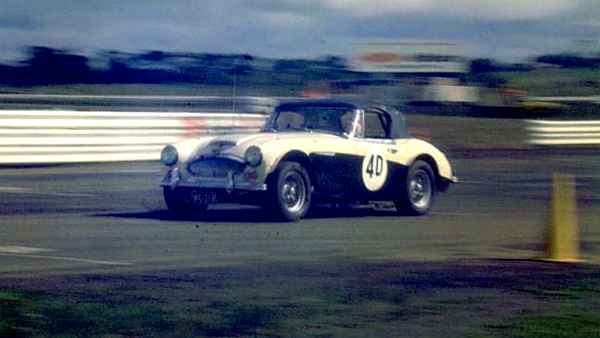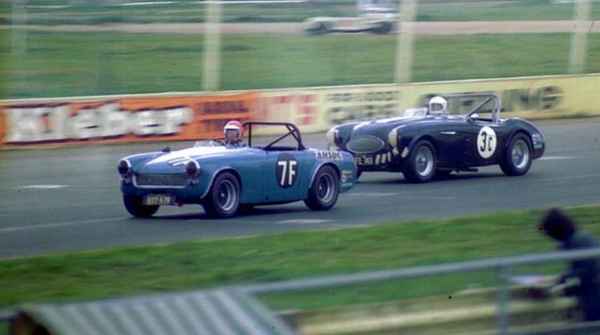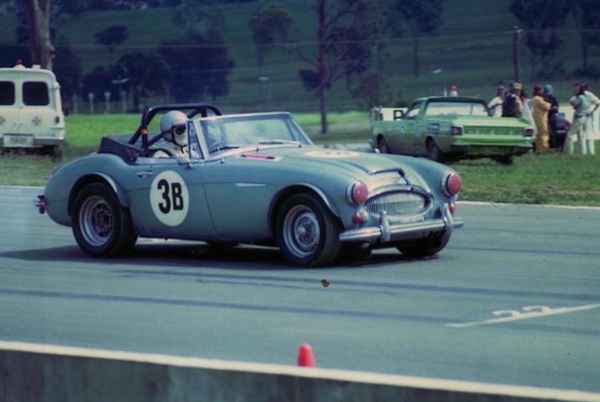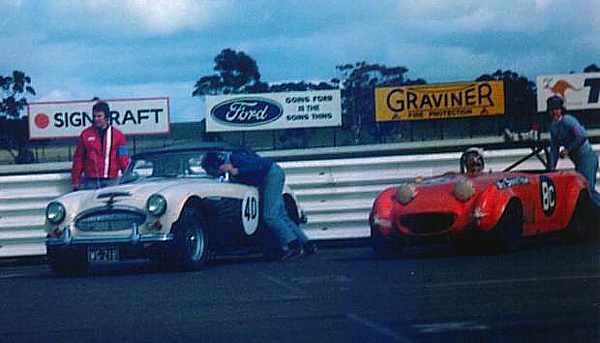
Patrick Quinn Esq. wrote this article for me about the 1973 6 hour relay race at Calder, Victoria. Patrick was part of the first AHOC 6 hour relay race team, along with Wally Gates (in the 'black & white car').
Dear Chris
To start with I would like to congratulate you on your website. It truly is wonderful and I believe that you have done proud by the Black and White car. Please keep it up and I look forward to seeing it expand to include new information about the car and perhaps even the early competition history and restoration of your BN1.
I note with some pleasure that you have included information about the various six-hour relay races that Wally Gates competed in and in particular the 1973 event. Perhaps you may allow me to contribute in my own small way to your site.
I see the names of the competitors in the 1973 event and with some sadness I see that I am the only one still involved with the Austin-Healey marque. Tragically Alan Jones (3000 MkI BT7) was killed in a car accident in 1979 while attending the Winton historic races. Peter Hopwood (3000 MkIII BJ8) succumbed to cancer a year or two back. I last saw Chris Gray (100 BN1 fitted with 100S front shroud and grille) at a Concours a few years ago and I don't know what he is up to now. Wally Gates (3000 MkIII BJ8) you know retired from the teaching profession and is now sunning himself in Queensland. Somehow I can't imagine Wally retired from anything and I suspect that he is busy on some project or another. He was the first fellow Austin-Healey owner I had met after I bought my BN1 in 1972 and he enthused me right from the start.

It's also hard to imagine that the 1973 six-hour relay race was twenty-eight years ago - just where has all that time gone? The Austin-Healey Owners Club was certainly a different club then to what it is now. Membership used to float around the 120 to 140 mark every year with the occasional car coming in from overseas. Non-running 100s could be had for around the $400 mark and if you sold it for $450 you were very happy with the result. You would have to pay around the $1,000 to $1,200 for a registered 100 in good condition. I paid top dollar to John Thompson Sports Cars for my BN1 at $1,295. There was another one for $1,100 that was bought by Jim Gray (Chris Gray's father), the last time I saw that car was during the late 1980s when it was in pieces at the Gray's home in Turramurra. There was also a red BJ8 going for $3,000 which was way out of my league - it was bought by Mal French which made me think that Qantas stewards were overpaid. It's funny thinking about it now that the BJ8 would have only been six to eight years old at the time and if my memory is right Mal eventually sold it to Western Australia.
Yes the cars were certainly far more affordable then in comparison to now which I have often thought is somewhat unfortunate. Sure we have all gained financially, but so what as you have to sell what you have to capitalise. I wonder how many true enthusiasts are out there that would love to buy an Austin-Healey but it's out of their reach?
Anyway enough of that and move on to the 1973 Calder Six-Hour Relay Race. As I said it was a very different AHOC back then. If we ended up in the black at the end of the financial year it was a successful year. However the whole club was very competition minded and looking back at a few records, the club had twenty-six starters at one Oran Park lap dash and thirty-three to an Amaroo Park hillclimb. It's no wonder we won the CSCA Championship by a mile. Yes I think the reason behind this was the cost of the cars and plus we were somewhat younger.
I can recall Alan Jones mentioning the relay race during a club meeting in 1973 and suggesting that the AHOC form a team. There was great enthusiasm from all involved and within just a couple of weeks Peter Hopwood and I were attending various CAMS lectures with the aim of achieving our competition licences. That was soon followed by our observed practice at Oran Park where we sailed through without difficulties. It should be said that obtaining a CAMS licence back then was a little easier than it is today.
A little time before that I had managed to blow the engine in a big way and for some time ran around with an Austin A70 Hereford unit under the bonnet courtesy of John Watson's father. There were none of the recognised repairers around back in the early 1970s and definitely no such thing as steel cranks and the like. Armed with a couple of cylinder heads of dubious quality and two cranks mostly courtesy of Wally Gates I headed towards Ken Waggott Speed Equipment who had agreed to rebuild the engine. Actually the trip was a story in itself as we removed the passenger seat from Doug Treloar's 3000 BT7 MkII and loaded the whole lot onto the floor, block and all. I sat on the passenger side jump seat regally waving to passers by.
My instructions to Waggott's were straightforward in that I wanted the bore to not go past +40 thou and very finally balanced. They did a great job as it had plenty of power and would rev way past the red line without any detriment. All up the engine rebuild cost just over $800.00 - yes it was a little cheaper to rebuild an engine back then too.
As I said club enthusiasm was riding high and besides the five drivers there was also a huge group of support people including a Team Manager and Team Mechanic. The president of the club at the time was Ben Sellers who is still involved in historic racing and also doubled as our Team Mechanic. Ben would bend over backwards to help, especially if you happened to own an Austin-Healey. So keen was Ben that he persuaded the team that it really had to practice for the relay. I can also remember being at Ben's home at Guildford in suburban Sydney up to 3am one Sunday rebuilding the gearbox from Peter Hopwood's MkIII. Anyway we agreed to hold a practice day at Oran Park on the outskirts of Sydney and thinking about it now I wondered what we were supposed to practice.

So around and around we went having a great time. We stopped on occasions to swap the sash, as during the actual event the drivers had to wear a sash around your neck and under your arm. The AHOC back then even had a club photographer on the committee. He was Warwick Foster who accompanied us to Oran Park and to Calder where he took both still and cine film - way before the days of video. I haven't seen Warwick for years.
My main memory of the Oran Park practice was Wally loosing the BJ8 in a big way and putting the car backwards into the wall at BP Energol (that's what it was called then). Wally was not a happy camper with his little escapade but in true Wally style set about to fixed the car then and there. How? Well he tied one end of a towrope to the stanchion supporting the main stand and the other end somehow to the rear shroud of the car and kept driving forward pulling the dent out from the car. By the time he had finished it didn't look too bad and when I saw the car the following weekend the car looked its normal immaculate self. That was Wally all over and so full of enthusiasm.
I took some leave prior to the event and fitted an aero screen, side exhaust and extractors to the car. I had made arrangements with fellow club member Kevin Gardner to tow the car to Calder behind his father's Valiant. Peter Hopwood was also towing his car and Alan left a week or so early to stay with his sister north of Melbourne and do all the preparatory work there. Wally in the BJ8? Well he drove the car of course with John Watson as passenger. I can't recall how Chris Gray got to the event.
Unfortunately the trip was not without adventure and remember this was before the Hume Highway was a four lane boring piece of bitumen and still meandered around every tree and hill. Back then Kevin and Christine Lyttle were an item so it was three up in the Valiant. The trip was no difficulty until just north of Seymour in Victoria when either the hired trailer swung across the middle of the road or a Toyota Crown did the same. Anyway both tried to occupy the same space at the same time with the result that I woke up from a sound sleep on the back seat to find the car and trailer both going sideways towards a rather large and unsympathetic gum tree. Luckily there was six inches of water on the side of the road, which slowed our sideways movement significantly.
Five minutes later around the corner comes Wally and John in the BJ8. They stop and with Vegemite sandwiches in hand run across to the scene to see if we were okay. Thankfully everyone was okay except I seem to remember that the Toyota driver was a little peeved about the damage to his almost new car. We told Wally that there wasn't much he could do and sent him to the next town to raise the alarm. Soon there was a mixture of police and tow trucks all over the place. The Crown had to be towed away while the trailer was completely lifted off the ground and taken into Seymour. The 100 was fine except for a little damage to the rear shroud. The police were very understanding and were quite happy for me to drive the BN1 to Calder. However we only got as far as Seymour where we met up with Peter and Carol Hopwood who were with fellow members Noel and Jo Laughton in their 327 HT Monaro. Peter suggested that we put my car on his trailer so that he could run his engine in driving the rest of the way. I went with him in his BJ8; Christine in the Monaro and poor Kevin remained in Seymour to sort of the mess.
After all that we finally managed to make it to Calder and our first practice. Actually this part is rather cloudy, as my grey cells have filed this away into a spot that is almost irretrievable. What I can recall is that we all circulated in unspectacular style. In fact it was so unspectacular that with the exception of Peter we looked as if we were out on a Sunday drive through the country. Peter was pushing his car hard and no doubt was enjoying himself. I should say that there were also teams from both the Victorian and South Australian Austin-Healey clubs.

We spent the late afternoon with Ben devising our race plan for the following day. Remember it was a six-hour event and we thought that it was just a simple matter of dividing that by five and getting stuck into it. Alan was to go out first, followed by Peter, then Chris, myself and finally Wally. No we didn't even consider that something would go wrong.
Sunday dawned clear and fresh with the start scheduled for 10am. If I remember that in addition to the drivers some thirty-six of our members had travelled to Melbourne for the event, really an amazing figure considering the size of our club at the time. It was a Le Mans start with Alan running across the straight and into his car where our team manager John Watson would fit him with the sash. After settling down Alan started to circulate very smoothly but just on thirty minutes into the race his car went off song and the sash was handed to Peter.
I have been involved with Austin-Healeys for close on to thirty years and I have met quite a few guys who could make them sing. However if I was to nominate the best it would have to be Ben Sellers and within a few moments he had sorted out Alan's car. Alan had quite correctly fitted a new set of points for the event but for no known reason the spring had lost its tension and therefore the points wouldn't close properly. Peter Hopwood was left to circulate for his hour plus period, which was greatly curtailed just twenty minutes later when a fan blade parted company from its partners.
Having a fan blade coming adrift is serious enough but as it made its escape it sliced through the radiator inlet pipe on the top header tank before bouncing off the underneath of the bonnet and slicing back through the header tank and into the radiator itself. Peter managed to get into the pits without serious damage to the engine and Chris Gray was sent on his way.
Luckily for the team there was the BJ8 of Victorian club member Graeme Rogers in the pits and he graciously allowed Peter and Ben to relieve it of its radiator and fan to install into Peter's car. By coincidence Andy had just a month or two prior purchased the car from long-term NSW club members Larry and Helen Johns.
Chris Gray's turn on the circuit was also beset by gremlins. Not long into his stint Chris's 100 went on to three cylinders and he came into the pits and I was sent out for my turn. Actually I wasn't due to go out on to the circuit for another 90 minutes but at least the car was fuelled and ready to go. It didn't take long for Ben to diagnose that the gap had closed up on a spark plug. The cause took a little extra time to find. Chris had recently had his carburettors rebuilt and one of the little screws that holds the butterfly on to the spindle had broken loose, found its way into the combustion chamber, push up by the piston on to the park plug and closed the gap. An amazing set of circumstances.

I recall motoring around the Calder circuit for some time and really enjoying myself. Not setting scintillating times but keeping to the lap times set for me, after all the team with the most completed laps would win. Almost an hour in when I heard a very familiar tapping sound from the gearbox. I had broken a tooth on second gear in the laygear. Wally went out in the black and white BJ8.
In typical Wally Gates style he just got stuck into it and circulated with great aplomb for over an hour with the occasional stoush while passing or being passed. Just before he was due to come him he signaled that he was coming in and Alan was made ready again. It turned out that Wally had noticed smoke coming out from behind the radio and naturally he was the butt of all our jokes as to why he had his radio on during a race.
Honestly Chris my memory of the remainder of the race is very cloudy but I do know that the maladies continued with Graeme Rogers once again providing parts on a short-term loan for Peter's car. It got to one stage that the only car was in any way going was my BN1 so I put in a further twenty minutes of two speed racing. Funny thing was that my lap times weren't much slower. I seem to remember that there was about eighty minutes left to run when I came back in and Wally and the black and white BJ8 was the only other car fit to run. So out he went and quickly settled into his quick and normal lap speeds for the remainder of the event. We were later very appreciative of Wally's efforts but that didn't stop us from asking him what station he had been listening to.
It was 4 pm and the checkered flag was waved and Wally came in to a rousing applause and back slapping from his fellow club members. He had done well and apart from the smoke escaping from the Lucas wiring the car performed faultlessly.
A considerable amount of liquid refreshment was consumed during the lull immediately after the event. I remember removing the numbers and our specially produced club logo and name from the car while at the same time as removing the paint as well. Thankfully Don Read had recently purchased a new air compressor and was eager to try it out when we got back to Sydney.
Where did we come out of some twenty plus teams? I think we came dead last but my hazy memory tells me that this was changed a little time later to second last. However that really didn't matter as we all agreed that our club spirit was at an all time high at that event. There were later relay races both at Calder and here in Sydney and they were great but didn't quite match the first with the amount of enthusiasm and enjoyment. I'm afraid to say that I haven't seen it since at a competition event.
There is another story here concerning getting back to Sydney. Borrowing a muffler, windscreen and such from Steve Pike, driving behind Kevin and Christine all the way back while they flat towed a hastily repaired trailer. The four wheel trailer being down to just two wheels, losing a wheel somewhere into the bush and having to buy new wheel nuts for the trailer. The driver's side wheel of the trailer pointing off at an angle and having the tyre blow out at 1 am in the morning. Trying to buy a tyre at 1:15 in the morning and dropping the trailer off at the hire place before dawn hoping they wouldn't notice the mess. Finally rushing home, having a shower, getting dressed and arriving at work trying to look as if I didn't need any sleep. Oh yes the trailer guy phoned me in the morning, I filled in lots of forms and never heard anything more.
I know that it was a long time ago Chris but I think that the 1973 Calder Six Hour Race would have to be one of the highlights of my almost thirty years of Austin-Healey ownership. Needless to say I am pleased to have shared it with fellow club members and their cars, including Wally and the Black and White 3000.
Regards
Patrick Quinn Esq
